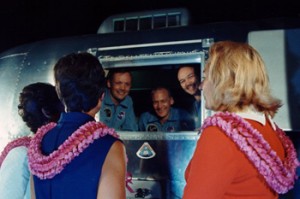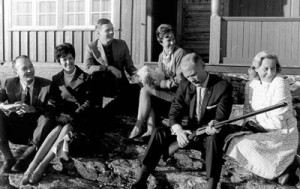Magnificent Isolation
Rather, the end of it. The crew of Apollo 11 didn’t realize how magnificent it was until they were thrust into a frenzied world after 19 days of quiet quarantine. From the moment they splashed down in the Pacific Ocean on July 24, 1969, they’d been penned up like three men in an episode of The Twil…
Rather, the end of it. The crew of Apollo 11 didn't realize how magnificent it was until they were thrust into a frenzied world after 19 days of quiet quarantine. From the moment they splashed down in the Pacific Ocean on July 24, 1969, they'd been penned up like three men in an episode of The Twilight Zone, having returned to their own people to find themselves captive curiosities, like fish in an aquarium or animals in a zoo.

Following a flight from Pearl Harbor, Hawaii, to Houston, their trailer was hooked up to Building 37 at the Manned Spacecraft Center (today the Johnson Space Center), where their quarantine continued in more spacious digs. The building housed the Lunar Receiving Laboratory, which included an apartment complex with private rooms for each man, common rooms, workrooms, a kitchen and dining room, and labs for studying the lunar material they'd brought back.
That post-flight period, during which NASA had the opportunity to fully debrief the crew (through panes of glass), was the last bit of peace and quiet the astronauts would enjoy for a very long time. Armstrong celebrated his 39th birthday during the quarantine, and was pleasantly surprised with a cake from the in-house chef, who shared their quarters along with another chef, a couple of doctors, a janitor, a journalist, and a NASA public relations official. Potential contamination with an adjacent lab where the study of moon rocks was in progress pulled six more people into the quarantine.
Then, on August 10, 1969, at about 9:00 on a Sunday evening, Armstrong, Aldrin, and Collins became free men, deemed at long last not to be health risks to planet Earth due to some unknown lunar germ they possibly had picked up on the moon. They were free to go home. Including their eight-day, 500,000-mile roundtrip flight, and their medical quarantine prior to that, they had been in seclusion for over a month.

Their freedom would be short-lived, with Monday their only day off at home. Tuesday saw a major press conference at the Manned Spacecraft Center in Houston, and Wednesday morning at 5:00 a.m. the beginning of a one-day, cross-country megatour for which Richard Nixon loaned them his presidential jet. Tickertape parades greeted them in New York and Chicago, and the day climaxed with a huge banquet at Los Angeles’s Century Plaza Hotel, attended by 1,440 guests including 50 astronauts, all of NASA’s top brass, 44 state governors, representatives of 92 foreign countries, entertainment industry heavies, Supreme Court justices, and the president and vice president and their families. The $43,000 gala’s menu included garden peas shelled by hand to prevent bruising, and a Claire de Lune ice cream dessert, each staked with an American flag.

Not to be excluded, Houston threw its big bash for the crew three days later, attended by 250,000. September 6 brought individual parades for each crewmember in his own hometown. September 9, they were brought to Washington for NASA’s Apollo 11 “Splashdown Party” at the Omni Shoreham Hotel, and an unveiling of the commemorative moon landing stamp at the U.S. Post Office. A week later the crew was summoned back to Washington to be honored at a joint session of Congress.
On September 29, the round-the-world “Giant Step” goodwill tour began, in which about 100 million people in 24 countries on six continents saw the astronauts, and an estimated 25,000 people shook their hands. The trip, again on the presidential jet, finished on November 5 with an overnight for the crew and their wives at the White House, complete with a private dinner with the president.

The whirlwind didn’t end there. Armstrong was off to Vietnam for Christmas with Bob Hope’s USO tour, as the requests for appearances and speaking engagements began to pour in.
But a trip he made the following May was perhaps the most intriguing: An invite to the Soviet Union, in which Armstrong—the second NASA astronaut to visit after Frank Borman—was received quietly in St. Petersburg. His visit had not been announced. He made a presentation to the International Committee on Space Research, and some days later visited Moscow and Star City. He met personally with Premier Alexei Kosygin. His personal hosts were cosmonauts Georgy Beregovoy and Konstantin Feoktistov, of Soyuz III and Voskhod I, respectively. After meeting the widows of Yuri Gagarin and Vladimir Komarov, and being led around Star City by Valentina Tereshkova, Armstrong was feted at a dinner attended only by the male cosmonauts, in which they presented him with a twelve-gauge double-barrel shotgun, his name engraved on the stock.
Apollo 11’s PR race seemed to have no finish line. But the other race was over, and the Soviets, good sports in the end, had done their part to recognize the triumph of Apollo 11. Although Armstrong had to turn over most of the official gifts he received to the U.S. government, he was allowed to keep the shotgun.

Following a flight from Pearl Harbor, Hawaii, to Houston, their trailer was hooked up to Building 37 at the Manned Spacecraft Center (today the Johnson Space Center), where their quarantine continued in more spacious digs. The building housed the Lunar Receiving Laboratory, which included an apartment complex with private rooms for each man, common rooms, workrooms, a kitchen and dining room, and labs for studying the lunar material they'd brought back.
That post-flight period, during which NASA had the opportunity to fully debrief the crew (through panes of glass), was the last bit of peace and quiet the astronauts would enjoy for a very long time. Armstrong celebrated his 39th birthday during the quarantine, and was pleasantly surprised with a cake from the in-house chef, who shared their quarters along with another chef, a couple of doctors, a janitor, a journalist, and a NASA public relations official. Potential contamination with an adjacent lab where the study of moon rocks was in progress pulled six more people into the quarantine.
Then, on August 10, 1969, at about 9:00 on a Sunday evening, Armstrong, Aldrin, and Collins became free men, deemed at long last not to be health risks to planet Earth due to some unknown lunar germ they possibly had picked up on the moon. They were free to go home. Including their eight-day, 500,000-mile roundtrip flight, and their medical quarantine prior to that, they had been in seclusion for over a month.

Their freedom would be short-lived, with Monday their only day off at home. Tuesday saw a major press conference at the Manned Spacecraft Center in Houston, and Wednesday morning at 5:00 a.m. the beginning of a one-day, cross-country megatour for which Richard Nixon loaned them his presidential jet. Tickertape parades greeted them in New York and Chicago, and the day climaxed with a huge banquet at Los Angeles’s Century Plaza Hotel, attended by 1,440 guests including 50 astronauts, all of NASA’s top brass, 44 state governors, representatives of 92 foreign countries, entertainment industry heavies, Supreme Court justices, and the president and vice president and their families. The $43,000 gala’s menu included garden peas shelled by hand to prevent bruising, and a Claire de Lune ice cream dessert, each staked with an American flag.

Not to be excluded, Houston threw its big bash for the crew three days later, attended by 250,000. September 6 brought individual parades for each crewmember in his own hometown. September 9, they were brought to Washington for NASA’s Apollo 11 “Splashdown Party” at the Omni Shoreham Hotel, and an unveiling of the commemorative moon landing stamp at the U.S. Post Office. A week later the crew was summoned back to Washington to be honored at a joint session of Congress.
On September 29, the round-the-world “Giant Step” goodwill tour began, in which about 100 million people in 24 countries on six continents saw the astronauts, and an estimated 25,000 people shook their hands. The trip, again on the presidential jet, finished on November 5 with an overnight for the crew and their wives at the White House, complete with a private dinner with the president.

The whirlwind didn’t end there. Armstrong was off to Vietnam for Christmas with Bob Hope’s USO tour, as the requests for appearances and speaking engagements began to pour in.
But a trip he made the following May was perhaps the most intriguing: An invite to the Soviet Union, in which Armstrong—the second NASA astronaut to visit after Frank Borman—was received quietly in St. Petersburg. His visit had not been announced. He made a presentation to the International Committee on Space Research, and some days later visited Moscow and Star City. He met personally with Premier Alexei Kosygin. His personal hosts were cosmonauts Georgy Beregovoy and Konstantin Feoktistov, of Soyuz III and Voskhod I, respectively. After meeting the widows of Yuri Gagarin and Vladimir Komarov, and being led around Star City by Valentina Tereshkova, Armstrong was feted at a dinner attended only by the male cosmonauts, in which they presented him with a twelve-gauge double-barrel shotgun, his name engraved on the stock.
Apollo 11’s PR race seemed to have no finish line. But the other race was over, and the Soviets, good sports in the end, had done their part to recognize the triumph of Apollo 11. Although Armstrong had to turn over most of the official gifts he received to the U.S. government, he was allowed to keep the shotgun.